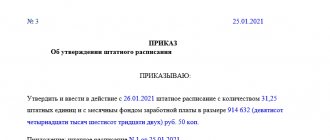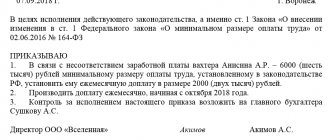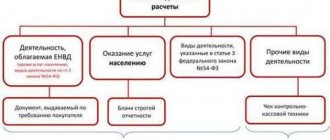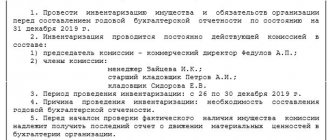The staffing table is needed to take into account the structure of the company, its number and composition. It records the positions, specialties, professions of employees, and an indication of their qualifications. When it is necessary to make a change to the staffing table (SH), an order is issued. The signed order is stored in a separate folder.
Changes can be proposed not only by senior management, but also by department heads. For this purpose, a memo is drawn up. Based on such a note, an order is prepared.
What change will have to be recorded in the SR:
- a new position has appeared, a new structural unit has been added;
- changed the job title, renamed the department;
- the tariff rate, salary changes (employee wages change);
- liquidate departments and vacant positions;
- are reducing staff and numbers.
Let's look at each of these cases in detail.
Making changes to the staffing table
The law does not establish the number of such documents, nor specific deadlines or periods for correction. As a rule, in such cases an order is issued to approve the ShR. If the innovations are not large-scale, you can get by with an order to make changes. It approves innovations, and they can be indicated in the text of the document or issued as an appendix. The document is signed by the head of the organization or a person authorized by him. There is no unified form; the employer has the right to develop it independently. The main principle is to record all the adjustments made. You can use our example of an order to change the staffing table.
Amendments are made in the following cases:
- when introducing a new position or a new structural unit;
- when their name changes;
- when the salary or tariff rate changes;
- when eliminating vacant positions and departments;
- when reducing staff or numbers.
Reasons for change
The reasons why amendments to the staffing table are required may vary. As already indicated, adjustments are made to the act by changing the current schedule or creating a new one. There is no third option.
A complete replacement of the “staff” is carried out if there are serious reasons for this. This could be personnel changes, reductions or expansion of staff, transfer of workers to another department, etc.
Minor adjustments are made to the schedule by issuing an order, which is signed by the head of the organization. An order is issued until the amendments are made. The reasons for issuing such an order may be:
- changing the names of departments and divisions;
- reduction in staffing levels;
- renaming of positions;
- making recalculations regarding wages;
- introduction or removal of a position.
The listed grounds can be used to adjust the current act. The main step in making a change is issuing an appropriate order. Such a document should contain an explanation of the upcoming changes.
If the order is drawn up with violations, then the amendments made to the staff act are recognized as not corresponding to reality if a dispute arises between the employer and the employee or during an audit. In some situations, in addition to issuing an order and making changes to the document, additional measures may be required.
Design example
When changes in the “staff” affect not just a few employees, but the entire enterprise as a whole, a new schedule is issued. This is done to avoid confusion. An example of the issuance of a new act is an increase in the level of the minimum wage in the region where the company is located, provided that the salary of workers depends on this indication.
Situations arise that require forced measures to be taken to provide employees with a shortened working week or day. This happens during crises, a decline in demand for a product and other nuances. The employer's goal in this case is:
- do not close production completely;
- do not leave people without jobs.
Example of an order for amendments
Such a decision is agreed upon with the employees of the enterprise, after which they are given notices of the changes. An additional agreement attached to the employment contract is also signed. It is compiled in two copies.
In practice, it is difficult to make adjustments to the entire staff in the schedule, so a new one is created. Before modifications are made to the act, appropriate grounds must appear. Otherwise, the manager does not have the right to change the personnel structure at his own discretion.
Proposals for making adjustments are set out by the heads of divisions and departments and are set out in a memo. A note is drawn up in a free format.
Petition
The reasons for changing the schedule are indicated in the memo (also called a petition). When the document in question is drawn up, it is required to register it in a special journal.
It is not legally established who has the right to draw up notes. Most often, the act is drawn up by personnel department employees. To compile, you need to know what changes are coming to the document. Also, the management of the departments has the right to draw up memos.
Example of a memo
There are no specific requirements regarding the preparation of the document. The compiler must adhere to the general rules for filling out this type of document:
- initially the “header” is written, which contains information regarding the originator and addressee;
- the name of the act is written;
- the document number is indicated;
- describes the content indicating the reasons for the adjustment;
- proposals for resolving this issue are included;
- signature of the author and its transcript.
After writing, the document must be registered in a special accounting journal. This journal is intended to record notes. According to this journal, the note is assigned a number. Next, the act is transferred to the company’s management, who makes the final decision regarding the need to make corrections.
Changing the title of a position or department
Renaming, as a rule, does not entail a correction in the labor function of an employee (or an entire department). If the labor function changes, then renaming cannot be carried out. It is required to formalize the transfer of an employee (or several employees) to a new position. Changing the name will entail making adjustments and additions to the employment contract, the work book and the employee’s personal card. Thus, such innovations not only require notification, but also consent from employees. In case of refusal, the employer should be guided by Art. 74 of the Labor Code of the Russian Federation, without missing the mandatory notification to the employee two months before the adjustments. You can use this sample order to change the staffing table.
Salary change
Initially, the schedule establishes the salary amount due to each position. As the company grows, there may be a need to make adjustments to this point, as the volume of labor increases and the financial capabilities of the enterprise increase.
Also, the grounds for changing the schedule may be provided for in legislation adopted at the federal level. Such acts establish an increase in the minimum wage.
According to labor law, the employer does not have the opportunity to set wages less than the minimum wage. For this reason, when making corrections to the value under consideration, it is necessary to adjust the schedule.
Staff reduction
These are the most time-consuming innovations and should be prepared in advance. The employer must ensure that vacant positions are removed from the SR and that the new structure meets the needs of the organization. Employees are notified of the upcoming dismissal by the employer personally and against signature at least two months in advance. The corresponding order must also be issued at least 2 months before making adjustments. To make changes to the staffing table, use the sample order below.
Unified form No. T-3
To print the staffing table, a unified form No. T-3 can be used, but the use of this particular form is not necessary. An organization can make changes or develop its own form.
The unified staffing form No. T-3 was approved by Resolution of the State Statistics Committee of the Russian Federation dated January 5, 2004 No. 1.
In the 1C ZUP 3.1 program, you can obtain a printed form of staffing table No. T-3 in several ways:
- From the reference book Staffing table Click the Print button - Staffing table (T-3) - the form is displayed as of the current date:
- Using the report Staffing (T-3) from the section Personnel - Personnel reports - you can generate No. T-3 for an arbitrary date:
How to notify employees?
The head of the organization must inform his subordinates about all changes that occur at the site, provided that they are related to the fulfillment of production tasks of employees. Familiarization should occur both upon hiring and during the course of work.
If the staff schedule changes, but it does not affect the activities of workers, then the boss is not required to inform his employees about this. This means that if management decides to add additional positions to the staff, then subordinates do not need to know about it.
If a reduction is planned, then those workers who have decided to be laid off need to know about it. The reduction is reported by notification in the form of an order, which the manager must provide to the employees against signature.
Naturally, subordinates should also know about changes in salaries. Those citizens whose salaries will be affected by the changes are brought up to date. Familiarization must be carried out in accordance with Article 74 of the Labor Code .
When do you need to provide reasons and is it mandatory?
There is no approved mandatory form of the order, but there are requirements for the composition of the details. The title of the order briefly conveys the essence of the order and corresponds to the content of the orders. For clerks and participants in the document flow of the enterprise, this detail helps to quickly find documents on the topic.
Example: “On the creation of a commission..”, “On rewarding participants...”, “On the results...”.
The text of the order must contain an introductory part, which is a substantiation of the reasons that prompted the instructions to be given. The justification may contain calculations, a list of events and their assessment, a link to previously adopted documents, and legal requirements.
Example: “For the purpose of implementing Government Order No. 665 dated August 3, 2014 and ensuring control of document flow.”
Such orders are administrative in nature and require compliance with the procedure for familiarizing the executors and interested officials with the document. The presence of a preamble in an administrative document allows you to record the connection of events and make clear the purpose of the actions that the executors of the order will need to perform after reading the order.
Preliminary setup of 1C ZUP
First of all, to enable the functionality we are considering, you need to make some settings. They are located in the “Settings” - “Human Resources” menu.
In the window that appears, follow the hyperlink “Setting up staffing”. A form will be displayed in front of you, where the first thing you need to do is set the flag on the item “Staffing is being maintained.” Also in this form you can set up automatic verification of personnel documents for compliance with the staffing schedule, enable history keeping and much more.
Our team provides consulting, configuration and implementation services for 1C. You can contact us by phone +7 499 350 29 00 . Services and prices can be seen at the link. We will be happy to help you!
Responsibility
In a situation where the employer does not make timely adjustments or does not fill out this schedule at all, he faces punishment under Article 5.27 part 4 of the Code of Administrative Offenses of the Russian Federation. This information is specified in Article 57 of the Labor Code.
In case of this violation, the manager faces a fine in the amount of 50 thousand to 100 thousand rubles.
The size of this sanction is not affected by the position of the offender. Also, if an official does not notify employees about making changes, he or she faces penalties. In these situations, company employees must file a corresponding complaint with the labor inspectorate.
She will initiate a case regarding violations and conduct an inspection at the enterprise in order to identify them. The employer will be fined and required to correct them as soon as possible.
Department settings
We create organizational divisions in the “Settings/Divisions” section.
Fig. 8 Forming divisions of the organization
Let's look at the subdivision display window.
Fig.9 Window for displaying units
At the top of it is the “Organization” field. If you check the box and select the organization you are interested in, the list will include only its departments. For convenience, the list of departments can be set to three viewing modes by clicking “More”:
- The “Hierarchical List” will not display all departments, but only the selected ones and those that are higher in the hierarchy.
- “List” will display all departments in a row, without showing nesting in higher ones;
- The most convenient option is “Tree”, which shows all the departments and where they are nested.
Fig. 10 The list of departments can be set to three viewing modes
Let's set up 1C:ZUP for the correct formation of the staffing table
When can you transfer an employee to 0.5 rates?
Such a transfer is acceptable upon entry to work or at any time during the period of employment. When transferring to 0.5 rates, not everything depends on the employer and employee - labor legislation imposes certain restrictions:
- establishes categories of employees for whom the employer cannot refuse a request for transfer to part-time (Part 2 of Article 93 of the Labor Code of the Russian Federation);
- stipulates the conditions and circumstances of the legal transfer of employees to part-time work at the initiative of the employer (Article 74 of the Labor Code of the Russian Federation).
According to labor legislation, transferring an employee to part-time work is possible:
- At the initiative of the employee
In addition, the employer does not have the right to refuse to change the essential terms of the employment contract to an employee who submits a medical report and an application for light work in connection with pregnancy (Part 1 of Article 254 of the Labor Code of the Russian Federation).
- At the initiative of the employer
If one of the conditions is not met, unilaterally transferring employees to part-time status (without their written consent) will be illegal.
The criteria for mass layoffs are determined in industry and (or) territorial tariff agreements or according to Government Decree No. 99 of 02/05/1993 (based on the number of workers laid off due to the liquidation of enterprises or a reduction in the number or staff of employees for a certain calendar period).
Changing the payroll method
There are times when it is necessary to change the method of calculating wages for one or more employees by replacing the salary with a tariff rate or vice versa. The reason may be: the frequent occurrence of overtime, an increase in labor intensity, and the length of the working day. Then, in order to optimize the accounting of time worked and wages, adjustments are made to the staffing table . Such adjustments must be justified and agreed upon with the employee in order to prevent a reduction in his salary. In the administrative section you can write the following:
From April 1, 2021, remove the position from the staffing table:
- laboratory technician with a salary of 20,000 rubles. - 1 PC. unit.
From April 1, 2021, introduce the following position into the staffing table:
- laboratory technician with an hourly rate of 120 rubles. - 1 PC. unit.
HR specialist L.N. Gordeeva notify laboratory technician Gusev S.E. about the change, prepare the relevant personnel documents.”
Employment service notification
The employer is obliged to notify the employment service in writing about the introduction of a part-time working regime, including when transferring employees to 0.5 wages, within 3 working days after the decision is made to carry out the relevant measures (Clause 2 of Article 25 of the Law of the Russian Federation of April 19, 1991 No. 1032-1 “On employment in the Russian Federation”).
Such information is mandatory if the transfer of employees to 0.5 rates is established at the initiative of the employer - in accordance with Art. 74 Labor Code of the Russian Federation.











